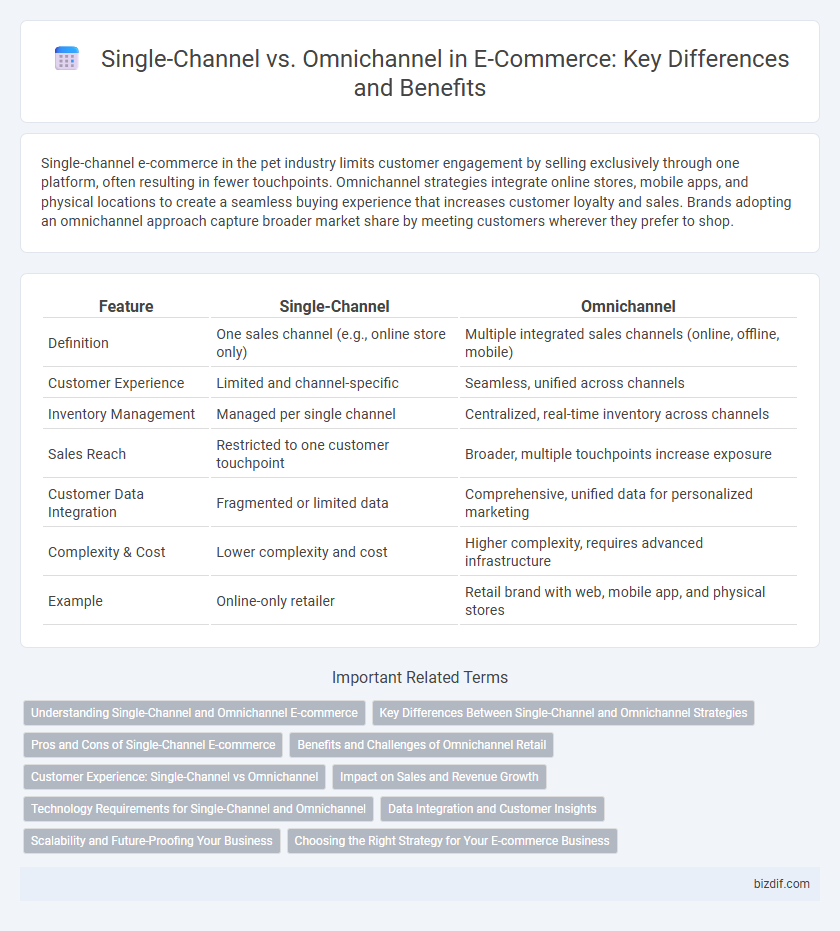Single-channel e-commerce in the pet industry limits customer engagement by selling exclusively through one platform, often resulting in fewer touchpoints. Omnichannel strategies integrate online stores, mobile apps, and physical locations to create a seamless buying experience that increases customer loyalty and sales. Brands adopting an omnichannel approach capture broader market share by meeting customers wherever they prefer to shop.
Table of Comparison
| Feature | Single-Channel | Omnichannel |
|---|---|---|
| Definition | One sales channel (e.g., online store only) | Multiple integrated sales channels (online, offline, mobile) |
| Customer Experience | Limited and channel-specific | Seamless, unified across channels |
| Inventory Management | Managed per single channel | Centralized, real-time inventory across channels |
| Sales Reach | Restricted to one customer touchpoint | Broader, multiple touchpoints increase exposure |
| Customer Data Integration | Fragmented or limited data | Comprehensive, unified data for personalized marketing |
| Complexity & Cost | Lower complexity and cost | Higher complexity, requires advanced infrastructure |
| Example | Online-only retailer | Retail brand with web, mobile app, and physical stores |
Understanding Single-Channel and Omnichannel E-commerce
Single-channel e-commerce involves selling products through one primary platform, such as a standalone website, limiting customer touchpoints and potentially reducing reach. Omnichannel e-commerce integrates multiple channels like online stores, mobile apps, social media, and physical locations to create a seamless, consistent shopping experience. This strategy enhances customer engagement, increases sales opportunities, and provides unified inventory and data management across all channels.
Key Differences Between Single-Channel and Omnichannel Strategies
Single-channel e-commerce focuses on selling through one platform, limiting customer touchpoints to a single digital or physical channel, whereas omnichannel strategies integrate multiple platforms to provide a seamless and consistent shopping experience across online, mobile, and in-store environments. Omnichannel strategies enhance customer engagement by synchronizing inventory, marketing, and customer service data, leading to improved personalization and higher retention rates. Single-channel approaches often suffer from fragmented customer data and limited reach, which can hinder scalability and overall customer satisfaction.
Pros and Cons of Single-Channel E-commerce
Single-channel e-commerce focuses all sales and customer interactions through one platform, simplifying inventory management and reducing operational costs. However, this approach limits customer reach and lacks the seamless shopping experience found in omnichannel strategies, potentially decreasing customer satisfaction and retention. Businesses relying solely on a single channel face higher risks if that platform experiences disruptions or declines in traffic.
Benefits and Challenges of Omnichannel Retail
Omnichannel retail integrates multiple sales channels, enhancing customer experience by providing seamless interactions across online, mobile, and in-store platforms, which increases customer loyalty and boosts sales conversion rates. Key benefits include improved data collection for personalized marketing and inventory optimization, while challenges involve complex technology integration, higher operational costs, and the need for consistent cross-channel communication. Retailers must invest in advanced analytics and unified commerce systems to effectively manage omnichannel strategies and meet evolving consumer expectations.
Customer Experience: Single-Channel vs Omnichannel
Single-channel e-commerce limits customer interactions to one platform, often leading to fragmented service and inconsistent user experiences. Omnichannel strategies integrate multiple touchpoints such as websites, social media, and physical stores, providing a seamless, personalized customer journey. Enhanced customer satisfaction and higher retention rates are typical outcomes of a well-executed omnichannel approach.
Impact on Sales and Revenue Growth
Single-channel e-commerce limits customer reach and interaction, often resulting in slower sales and stagnant revenue growth due to fewer touchpoints. Omnichannel strategies integrate multiple sales channels, increasing customer engagement, improving conversion rates, and driving significant revenue growth by delivering a seamless shopping experience. Data shows businesses with omnichannel approaches see up to a 30% higher lifetime customer value and 15% more revenue compared to single-channel retailers.
Technology Requirements for Single-Channel and Omnichannel
Single-channel e-commerce relies on a singular technology stack tailored to one platform, often focusing on a standalone website or app with basic inventory management and payment processing systems. Omnichannel e-commerce demands integrated technologies such as CRM, ERP, POS systems, and sophisticated API connections to unify customer experience across online, mobile, and physical stores. Advanced data analytics, real-time inventory synchronization, and personalized marketing tools are critical technology components for successfully implementing an omnichannel strategy.
Data Integration and Customer Insights
Single-channel e-commerce limits data collection to one platform, resulting in fragmented customer insights that hinder personalized marketing strategies. Omnichannel integration consolidates data from various touchpoints, enabling a unified customer profile and advanced analytics for targeted promotions. Effective data integration enhances real-time decision-making, improves customer experience, and increases conversion rates through cohesive channel interactions.
Scalability and Future-Proofing Your Business
Single-channel e-commerce limits scalability by restricting sales to one platform, making it harder to adapt to market changes and customer preferences. Omnichannel strategies integrate multiple sales channels, enhancing customer reach and providing seamless experiences, which supports sustainable growth and future-proofing. Investing in omnichannel infrastructure enables businesses to quickly pivot and scale operations, maintaining competitiveness in evolving digital landscapes.
Choosing the Right Strategy for Your E-commerce Business
Single-channel e-commerce focuses on selling through one platform, simplifying management but limiting customer reach and engagement. Omnichannel strategies integrate multiple platforms like online stores, social media, and physical locations to create a seamless shopping experience, boosting customer loyalty and sales opportunities. Choosing the right approach depends on your business size, target audience, and resources to optimize customer convenience and maximize revenue.
Single-channel vs Omnichannel Infographic

 bizdif.com
bizdif.com